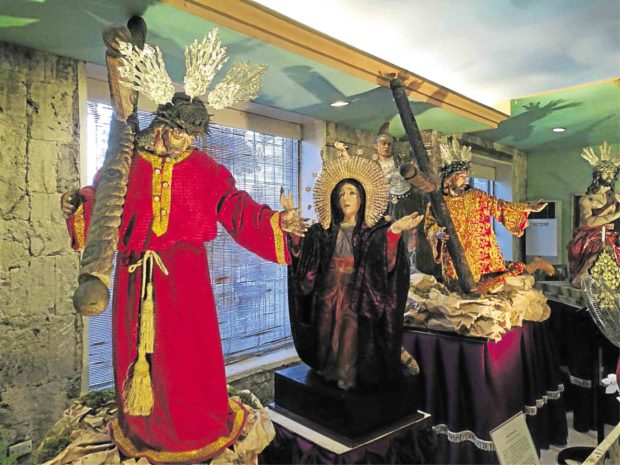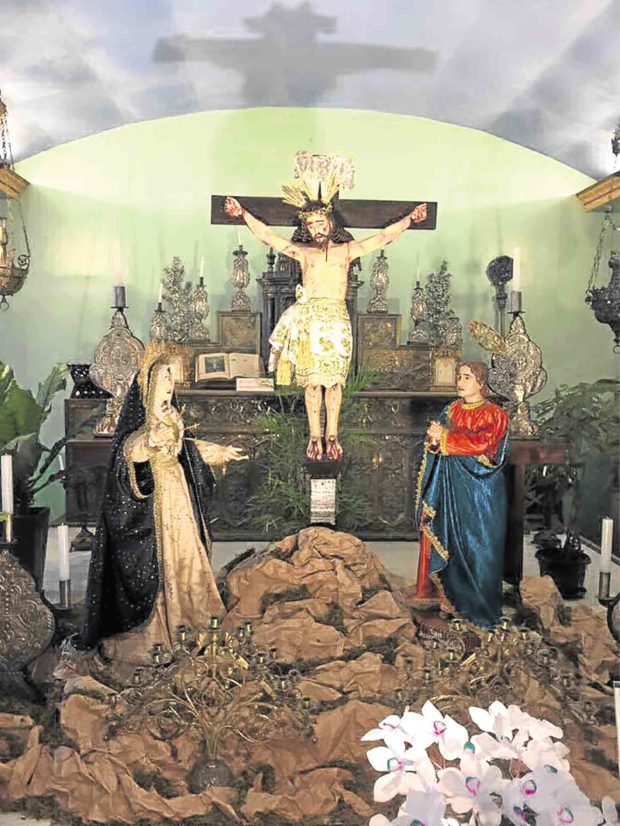Cebu’s Lenten tradition: Procession of the Pasos

REDEMPTION FROM SIN Heirloom images depicting the passion of Jesus Christ are displayed in a Holy Week procession in Cebu province to remind the Catholic faithful of the Lord’s sacrifice to redeem mankind from the slavery of sin. —CONTRIBUTED PHOTOS
CEBU CITY — It was five centuries ago when the Pasos procession was first introduced in the Philippines by Spanish missionaries but the devotion had not died down.
From a tableau of Jesus’ Last Supper with his apostles to an image of the dead Christ lying in repose, the procession has become part of the rich tradition of Holy Week to commemorate the passion and death of the Lord.
Dr. Clodoveo “Louie” Nacorda, heritage enthusiast and renowned Cebuano church art collector, saw the need to revisit the tradition of the Pasos to make sure people fully understand the meaning behind the images that portray Jesus’ final hours instead of just simply identifying the personalities involved in the story of redemption.
“The Pasos are meant to instill in the hearts and minds of the faithful the price of our redemption and the love of God as shown by the willing sacrifice Jesus Christ made to redeem mankind from the slavery of sin,” he said in a recent lecture on “Pasos de Cuaresma” (Lenten Pasos) at Casa Gorordo Museum here.
Renewal of faith
Article continues after this advertisementThe ultimate goal of the procession is the strengthening and renewal of faith, he said.
Article continues after this advertisement“Religious processions are public manifestations of the faith. It is a prayer in motion and as such, proper disposition and behavior are required,” Nacorda said.
Derived from the Spanish word “paso,” or step, the Pasos event takes the faithful back to Jesus’ ultimate sacrifice to save mankind over 2,000 years ago.
The procession, usually done twice during the Holy Week, includes solitary images of the sorrowful Blessed Virgin Mary, the apostles and the women disciples who stayed with Jesus before he breathed his last.
Bantayan archives
The oldest known image of the Pasos in the Philippines is Nuestro Padre Jesus Nazareno of Quiapo, Manila, which was brought by the Augustinian Recollects from Mexico in 1606.
In Cebu, Saints Peter and Paul Parish of Bantayan town on Bantayan Island has the biggest number of religious images and tableau depicting the passion and death of Jesus.
The original processional images were listed by former parish priest Leoncio Aguilar in the June 1887 inventory, now in the parish archives.
Heirloom images
At present, 33 heirloom images and tableau of the passion of Jesus Christ are brought out during the Good Friday procession in Bantayan.
Also popular for their Pasos images in Cebu are the Archdiocesan Shrine of St. Catherine of Alexandria in Carcar City, National Shrine of St. Joseph in Mandaue City, Cebu Metropolitan Cathedral and St. Francis of Assisi Parish in Balamban town.
The common passion tableau include the Last Supper; the agony in the garden of Gethsemane; Jesus’ arrest and trial before Pontius Pilate; the scourging at the pillar; the crowning of thorns; the carrying of the cross; the Crucifixion; “La Pieta,” or the image of the Virgin Mary cradling the dead Jesus; and the burial of the Lord.
Another image, which not all parishes possess, is “Señor del Desmayo,” which depicts how Jesus fainted after He was whipped about 40 times.
Scourging
A person who was to be scourged must receive not more than 40 lashes, Nacorda said, citing Jewish law. A “whip of mercy” brings down the number to 39.
According to records, a Roman scourge has three leather ropes attached to a wood handle. On each length of the rope, there would be a number of bone pieces attached at intervals of every 3 inches.
With the sharp edges, the bones cut deeply into anybody’s skin.
Aside from the tableau of Jesus’ passion and death, those who accompanied Jesus in His final hours are also presented in the Pasos.
These include Jesus’ mother, popularly known as “Mater Dolorosa” (Sorrowful Mother); St. John the Evangelist; St. Peter; St. Mary Magdalene; St. Mary Jacobe; St. Salome; and St. Veronica.
St. John was the only apostle who stayed with Jesus until His death in Calvary.
St. Mary Magdalene, on the other hand, was the woman Jesus freed from seven demons and was among the few who were on the foot of the cross, and who, on Easter Sunday morning, Jesus sent to tell the apostles that he had risen from the dead.
St. Mary Jacobe, depicted as carrying the “flagrum,” or Roman whip, or in some images a broom, was the mother of St. James the Lesser, one of the apostles of Jesus.
St. Salome, another follower of Jesus, brought an incense. By tradition, the woman who wiped the bloodied face of Jesus using her veil was known as St. Veronica.
St. Martha of Bethany, who prepared meals for Jesus and his disciples, joined the women in the passion of Christ.
The other personalities in the passion of Christ were Joseph of Arimathea, a follower of Jesus, who, along with Nicodemus, a Pharisee who came to see Jesus one of those nights, cleaned and buried the body of the Lord; and St. Longinus, the Roman soldier who pierced the side of Jesus and was eventually converted.
Repentant St. Peter
Nacorda said the image of the repentant St. Peter usually led the Pasos procession and the sacred walk on Good Friday since the icon embodied the essence of Lent: repentance.
“The St. Peter you see in the Pasos is the image of the apostle who denied Christ three times, never lost hope and repented. He represents the true essence of Lent because he mirrors all of us, sinners, who should find our way back to God,” he said.
Nacorda said the Pasos images must remind people to ponder upon the sacred passion of the Lord.
“The images of the passion constantly remind us how much God loves us, and what he did to save us from eternal death. Being devoted to the images should bring us closer to Christ,” he said.
